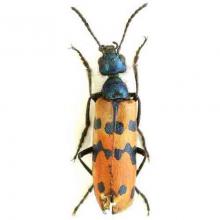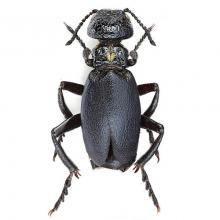Mylabris mongolica
Common name:
Northern blisterbeetle
Genus:
Mylabris
Family:
Meloidae
Suborder:
-n/a-
Meloe centripubens
Common name:
Blister beetle
Genus:
Meloe
Family:
Meloidae
Suborder:
Polyphaga
Mylabris mongolica
Common name:
Northern blisterbeetle
Genus:
Mylabris
Family:
Meloidae
Suborder:
-n/a-
Meloe centripubens
Common name:
Blister beetle
Genus:
Meloe
Family:
Meloidae
Suborder:
Polyphaga
Mylabris mongolica
Common name:
Northern blisterbeetle
Genus:
Mylabris
Family:
Meloidae
Suborder:
-n/a-
Meloe centripubens
Common name:
Blister beetle
Genus:
Meloe
Family:
Meloidae
Suborder:
Polyphaga
Family (Animalia): Meloidae
Blister beetles are beetles of the family Meloidae, so called for their defensive secretion of a blistering agent, cantharidin. About 7,500 species are known worldwide. Many are conspicuous and some are aposematically colored, announcing their toxicity to would-be predators.
Description
Blister beetles are hypermetamorphic, going through several larval stages, the first of which is typically a mobile triungulin. The larvae are insectivorous, mainly attacking bees, though a few feed on grasshopper eggs. While sometimes considered parasitoids, in general, the meloid larva apparently consumes the immature host along with its provisions, and can often survive on the provisions alone; thus it is not an obligatory parasitoid, but rather a facultative parasitoid, or simply a kleptoparasite. The adults sometimes feed on flowers and leaves of plants of such diverse families as the Amaranthaceae, Asteraceae, Fabaceae, and Solanaceae.
Cantharidin, a poisonous chemical that causes blistering of the skin, is secreted as a defensive agent. It is used medically to remove warts and is collected for this purpose from species of the genera Mylabris and Lytta, especially Lytta vesicatoria, better known as "Spanish fly".
Toxicity
Cantharidin is the principal irritant in "Spanish fly", a folk medicine prepared from dried beetles in the family Meloidae.
The largest genus, Epicauta, contains many species toxic to horses. A few beetles consumed in a single feeding of alfalfa hay may be lethal. In semiarid areas of the western United States, modern harvesting techniques may contribute to cantharidin content in harvested forage. The practice of hay conditioning, crushing the stalks to promote drying, also crushes any beetles present and causes the release of cantharidin into the fodder. Blister beetles are attracted to alfalfa and weeds during bloom. Reducing weeds and timing harvests before and after bloom are sound management practices. Using equipment without hay conditioners may reduce beetle mortality and allow them to escape before baling
Reference: Wikipedia


